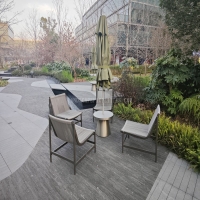Welcome to the website for landscape facilities products and knowledge.
How does the table perform in high-traffic environments like coworking spaces or conference halls?
In today's dynamic work environments, tables face unprecedented challenges in high-traffic settings such as co-working spaces and conference halls. These demanding environments require furniture that can withstand constant use while maintaining structural integrity and aesthetic appeal.
Modern commercial tables achieve exceptional performance through advanced engineering and material selection. High-pressure laminate surfaces resist scratches, stains, and impact damage, while reinforced edges prevent chipping from frequent movement. The core materials often include high-density particleboard or marine-grade polymer compositions that offer superior moisture resistance and dimensional stability.
The structural design incorporates reinforced leg systems with cross-bracing and additional support bars that distribute weight evenly. Many manufacturers employ powder-coated steel frames that provide exceptional load-bearing capacity while resisting corrosion. Table joints feature advanced fastening systems that maintain stability despite repeated assembly and disassembly for flexible space configurations.
Surface technology has evolved significantly, with many commercial tables now featuring antimicrobial coatings that inhibit bacterial growth – a crucial consideration in shared environments. The integration of cable management systems within table designs maintains organization while protecting electrical components from damage.
Durability testing standards for commercial furniture typically include cycle tests simulating years of use, weight capacity assessments exceeding typical requirements, and chemical resistance evaluations. Leading manufacturers subject their products to equivalent of 10-15 years of intensive use during development phases.
The integration of technology represents another critical aspect, with many tables now incorporating built-in power outlets, USB ports, and data connections that withstand constant plugging and unplugging. These integrated solutions reduce cable clutter and minimize wear on table surfaces.
Environmental factors also play a significant role in table performance. Humidity-resistant materials prevent warping, while UV-stable finishes maintain color fidelity under constant exposure to artificial lighting. Temperature fluctuations in large spaces are accommodated through expansion joints and material selections with low thermal conductivity.
Maintenance considerations have driven innovations in surface textures that hide fingerprints and smudges, reducing cleaning frequency without compromising appearance. The modular nature of many modern table systems allows for individual component replacement, extending the overall product lifespan significantly.
Ultimately, the performance of tables in high-traffic environments depends on a holistic approach to design that balances durability, functionality, and aesthetics. Through rigorous testing and innovative material applications, today's commercial tables deliver reliable performance that meets the demanding requirements of modern shared workspaces and event venues.
Related search:

Recommendation
Metal structure rattan chair without armrests for single person, with woven seat and backrest.